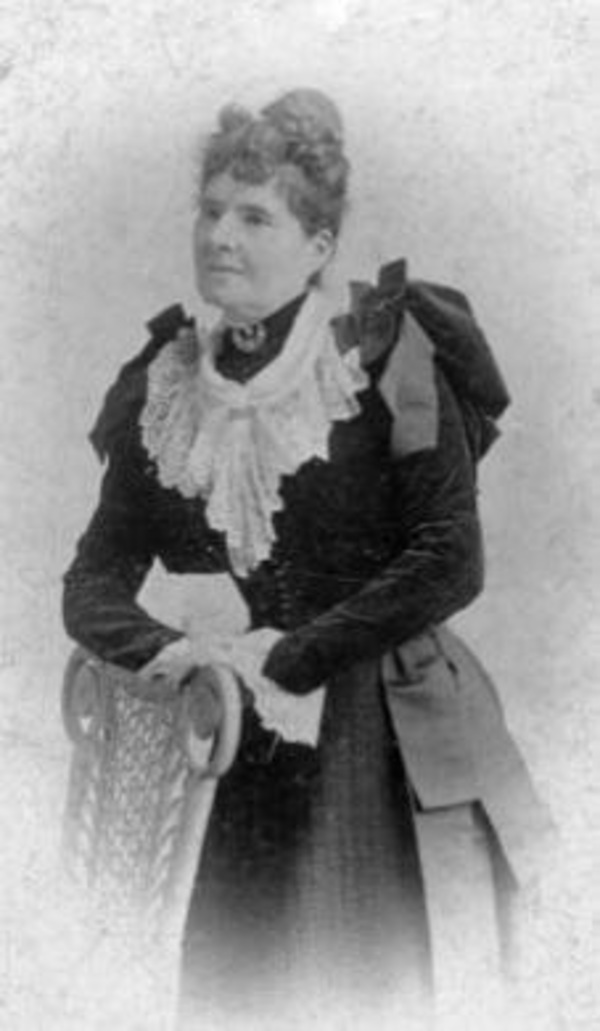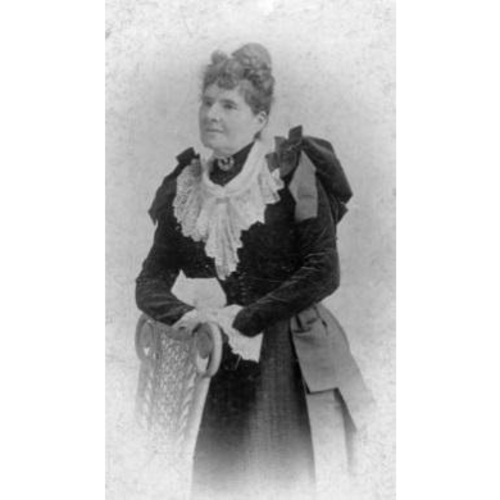
Source: Link
ROSS, FLORA AMELIA (Hubbs), matron and asylum administrator; b. c. 1842, perhaps on San Juan Island (Wash.); daughter of Charles Ross and Isabella Mainville; m. 6 Dec. 1859 Paul Kinsey Hubbs Jr, and they had a son; d. 2 Nov. 1897 in New Westminster, B.C.
Flora Amelia Ross was the child of a fur-trade family. Her father was chief trader for the Hudson’s Bay Company at Fort McLoughlin (Bella Bella, B.C.) and later at Fort Victoria (Victoria); her mother was the daughter of a trader and an Ojibwa woman. On 6 Dec. 1859 she married Paul Kinsey Hubbs Jr, the American deputy collector of customs on the San Juan Islands. Hubbs was described by Dr John Sebastian Helmcken* as “a rowdy – ignorant hoodlum – who thought an American ought to be boastful and a bully.” Hubbs had tried to “bully” Flora, and as a result she divorced him in 1866. She reverted to her family name and informally changed the name of their son from Paul Kinsey Hubbs to Charles Ross.
In that year Flora Ross was appointed matron of the Victoria jail, primarily to look after three mentally ill women who were being housed there. In October 1872 Ross followed her charges to the newly opened Asylum for the Insane situated on the nearby Songhees reserve, where she became matron of the women’s ward at an annual salary of $400 plus room and board for herself and her ten-year-old son. She retained this position when in 1878 the asylum was relocated to New Westminster.
Initially her hold on the post was somewhat precarious. In 1874 superintendent E. A. Sharpe demanded that Ross resign so that he could appoint his new wife matron. A flurry of correspondence resulted between Sharpe, Ross, and Provincial Secretary Dr John Ash* in which Sharpe charged Ross with insubordination, infractions of asylum rules, theft, and visiting with “half-breeds.” Ross responded that Sharpe had treated her in a “degrading manner” that undermined her influence with her patients, and she stated that the “half-breeds” of whom he spoke were, in fact, “ladies . . . of the highest respectability; most of them moving in the best society in Victoria.” The controversy dragged on for 11 months during which time Sharpe continued to harass Ross, demanding that she remove her son from the asylum, prohibiting her from using the kitchen or seeking aid from other attendants, and calling her an “Indian . . . woman with a dozen husbands.” Ross, however, had the support of her fellow employees as well as that of the provincial government and weathered these attacks, tenaciously refusing to resign. Ultimately Sharpe was dismissed and Ross was given sole authority over female patients. However much Victoria society had changed by the 1870s, some fur-trade children, like Ross, maintained their connections with the provincial élite in ways that newcomers such as Sharpe obviously underestimated. Having withstood this attack, Ross retained her authority over the female ward of the Asylum for the Insane, and it was never again seriously challenged.
Ross continued as matron through four more male superintendents and two public investigations into asylum management. Reports from these inquests, though generally unfavourable, consistently praised Ross’s work. By 1893 she had 4 assistant matrons and 41 patients under her supervision. Entirely self-taught on the subject of mental therapeutics, she maintained her ward efficiently, engaging her patients in a variety of household tasks, organizing regular dances, games, and long walks on the asylum grounds. In contrast to the male sections of the institution, the female section employed a minimum of mechanical restraints on patients. When faced with profoundly self-destructive women, Ross used a camisole that she constructed from a man’s shirt and that was cut in the front to prevent the near-asphyxiation caused by the straitjackets used on the men’s ward. On being asked if she ever used a regular straitjacket on her patients she replied, “If my medical superintendent was to order me to put one on my patients . . . I should deliberately and coolly disobey him.”
When a new medical superintendent was appointed in 1895, he described the women’s ward as the “one bright spot” in the institution and looked forward to the day when male patients would receive the kind of care that Ross gave her women. In 1897 Ross became ill with cancer and her final request was that she be allowed to die in the asylum, which had been the focus of her life for a quarter century. After several months of sickness, she died. By this time her son, Charles, was engaged in mining at Slocan; ever intolerant of irresponsible men, Ross refused to grant him “his legacy” until he proved himself to be a “fit and proper person.” She left it in trust, and bequeathed the rest of her assets to the Church of England, her women friends, and her patients.
[The author would like to give special thanks to Val Adolph of the Woodlands School (New Westminster, B.C.), which uses the old asylum buildings, for the information she provided. m.-e.k.]
Christ Church (Anglican) Cathedral (Victoria), Reg. of marriages, 6 Dec. 1859. PABC, GR 693, F 549: 2; Vert. file, Charles Ross, including will of F. A. Ross. B.C., Legislative Assembly, Journals, 1874, “Sessional papers,” 332; Sessional papers, 1876: 661–72; 1895: 556–59; 1898: 836. Helmcken, Reminiscences (Blakey Smith and Lamb), 164n. Daily British Colonist and Victoria Chronicle, 14 Jan. 1870. Harry Gregson, A history of Victoria, 1842–1970 (Victoria, 1970). H. M. Hurd et al., The institutional care of the insane in the United States and Canada, ed. H. M. Hurd (4v., Baltimore, Md., 1916–17; repr. New York, 1973), 4: 9–10. Sylvia Van Kirk, “Many tender ties”: women in fur-trade society in western Canada, 1670–1870 (Winnipeg, [1980]).
Bibliography for the revised version:
The DCB/DBC is grateful to Kathryn E. Irwin and D. J. Richardson for their assistance in identifying the correct Paul Kinsey Hubbs.
FamilySearch, “United States census, 1860,” Flora Hubbs: familysearch.org/ark:/61903/1:1:MC6W-3G4?cid=fs_copy (consulted 6 June 2024). Wash., Secretary of State, Wash. State Arch., digital arch., “Frontier justice: territorial court case files,” Jefferson frontier justice, 1866, case no.482: digitalarchives.wa.gov/Record/View/AF795B173C0CAC08910E028B19AA3F54 (consulted 6 June 2024). New Westminster Times (Victoria), 10 Dec. 1859. San Juan Islander (Friday Harbor, Wash.), 18 Feb. 1910. J. P. Munro-Fraser, History of Solano County … (San Francisco, 1879), 364.
Cite This Article
Mary-Ellen Kelm, “ROSS, FLORA AMELIA (Hubbs),” in Dictionary of Canadian Biography, vol. 12, University of Toronto/Université Laval, 2003–, accessed January 2, 2026, https://www.biographi.ca/en/bio/ross_flora_amelia_12E.html.
The citation above shows the format for footnotes and endnotes according to the Chicago manual of style (16th edition). Information to be used in other citation formats:
| Permalink: | https://www.biographi.ca/en/bio/ross_flora_amelia_12E.html |
| Author of Article: | Mary-Ellen Kelm |
| Title of Article: | ROSS, FLORA AMELIA (Hubbs) |
| Publication Name: | Dictionary of Canadian Biography, vol. 12 |
| Publisher: | University of Toronto/Université Laval |
| Year of publication: | 1990 |
| Year of revision: | 2024 |
| Access Date: | January 2, 2026 |



